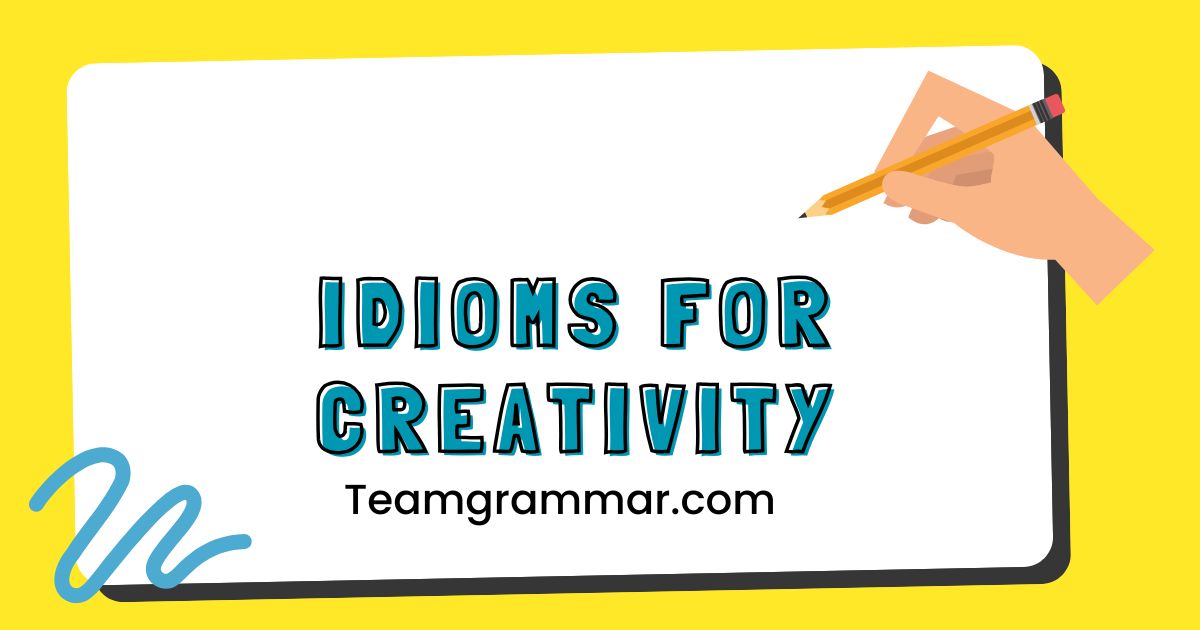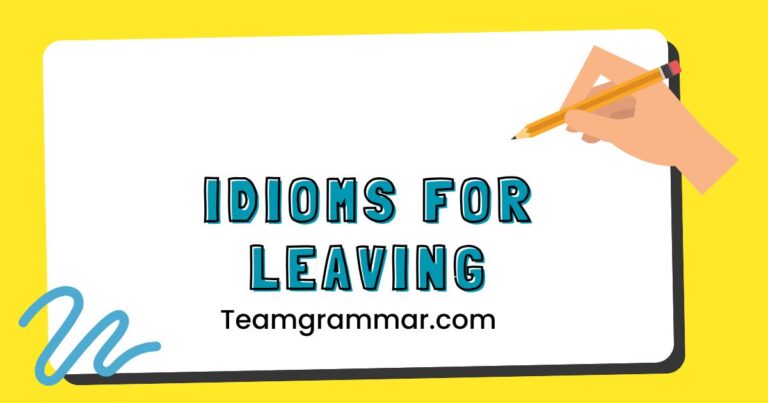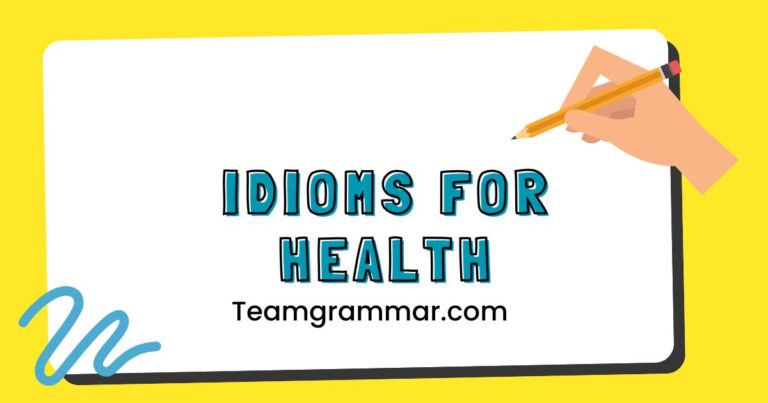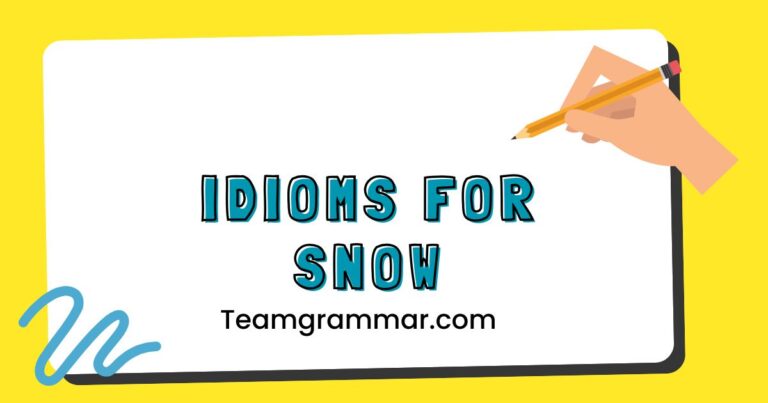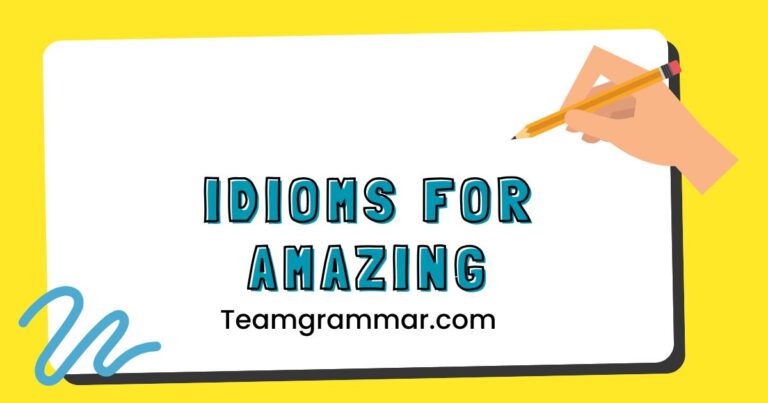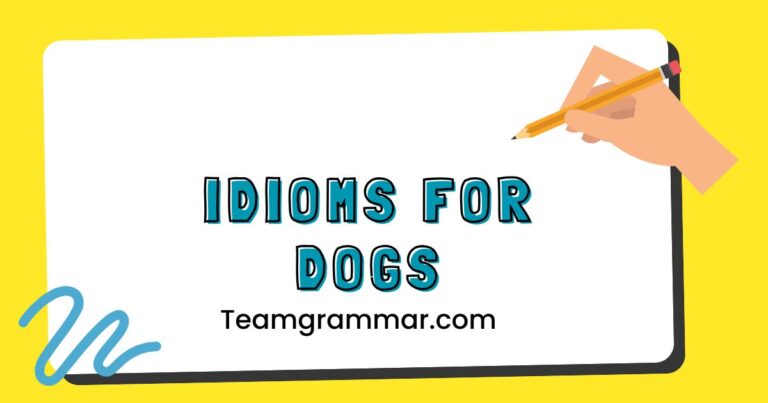43 Idioms for Creativity: Unleash Your Linguistic Imagination
Creativity, the engine of innovation and artistic expression, often finds its most vivid expression through language. English, with its rich tapestry of idioms, provides a particularly fertile ground for conveying creative concepts in unique and memorable ways.
Understanding and using idioms related to creativity can significantly enhance your ability to communicate original ideas, inspire others, and add color to your writing and speech. This article delves into the world of idioms for creativity, exploring their meanings, usage, and the nuances they bring to the English language.
Whether you’re a student, writer, or simply someone looking to expand your linguistic toolkit, this guide will equip you with the knowledge to unlock the power of idioms to express creativity.
Table of Contents
- Introduction
- Definition of Idioms for Creativity
- Structural Breakdown of Creative Idioms
- Types and Categories of Idioms for Creativity
- Examples of Idioms for Creativity
- Usage Rules for Idioms of Creativity
- Common Mistakes When Using Idioms for Creativity
- Practice Exercises
- Advanced Topics: Nuances and Context
- FAQ: Frequently Asked Questions
- Conclusion
Introduction
The English language is replete with idioms – colorful expressions that add depth and nuance to communication. When it comes to describing creativity, idioms provide a particularly powerful tool.
They allow us to convey complex ideas in a concise and memorable way, painting vivid pictures in the minds of our audience. Mastering these idioms can transform your writing and speech, making you a more effective and engaging communicator, especially when discussing innovation, originality, and imaginative thinking.
This article serves as a comprehensive guide to understanding and utilizing idioms related to creativity, enhancing your ability to express and appreciate the creative process.
Definition of Idioms for Creativity
Anidiomis a phrase or expression whose meaning cannot be understood from the literal meanings of the individual words that comprise it. Instead, the idiom’s meaning is figurative and culturally specific.Idioms for creativityare a subset of idioms that specifically relate to the processes, qualities, and outcomes of creative thought and action.
These idioms often describe the act of generating new ideas, thinking outside the box, or achieving innovative results. They provide a shorthand way to communicate complex concepts related to creativity, adding color and emphasis to your language.
Idioms for creativity can be classified based on their function and the specific aspect of creativity they describe. For example, some idioms focus on the initial spark of inspiration, while others describe the process of developing an idea or the final result of a creative endeavor.
Understanding these classifications can help you choose the most appropriate idiom for a given context, ensuring that your message is clear and impactful.
Structural Breakdown of Creative Idioms
The structure of idioms for creativity, like all idioms, varies significantly. Some are simple phrases consisting of a few words, while others are more complex sentences.
The key characteristic is that the meaning is non-literal. For instance, “thinking outside the box” is a common idiom for creativity.
Let’s break down some common structural elements:
- Verbs of Action: Many idioms use verbs that imply action or process, such as “brainstorm,” “cook up,” or “hammer out.” These verbs suggest the active nature of creative thinking.
- Metaphors and Similes: Idioms often employ metaphors and similes to create vivid imagery. For example, “a lightbulb moment” uses the metaphor of a lightbulb turning on to represent a sudden realization or inspiration.
- Figurative Language: Idioms rely heavily on figurative language, such as hyperbole (exaggeration) and understatement, to convey their meaning.
- Prepositional Phrases: Prepositional phrases are frequently used to add context and detail to idioms. For example, “outside the box” specifies the type of thinking being described.
Understanding these structural elements can help you better understand and appreciate the nuances of idioms for creativity. It also allows you to more effectively incorporate them into your own writing and speech, adding depth and color to your communication.
Types and Categories of Idioms for Creativity
Idioms for creativity can be categorized based on the specific aspect of the creative process they describe. Here are some common categories:
Idioms Related to Idea Generation
These idioms describe the process of coming up with new ideas, often through brainstorming or other creative techniques.
Idioms Related to Innovation
These idioms focus on the creation of new and original products, services, or processes.
Idioms Related to Originality
These idioms emphasize the uniqueness and novelty of a creative idea or work.
Idioms Related to Inspiration
These idioms describe the spark or motivation that drives creative endeavor.
Idioms Related to Thinking Creatively
These idioms focus on the mental processes involved in generating new ideas and solving problems in innovative ways.
Examples of Idioms for Creativity
This section provides a comprehensive list of idioms for creativity, organized by category, with examples to illustrate their meaning and usage. Each table below contains numerous examples to help you fully understand these expressions.
Idioms Related to Brainstorming
Brainstorming is a crucial part of the creative process, focusing on generating a large number of ideas. The following table presents idioms related to brainstorming, providing examples of their use in sentences.
| Idiom | Meaning | Example Sentence |
|---|---|---|
| Brainstorm | To generate a lot of ideas quickly. | Let’s brainstorm some ideas for the new marketing campaign. |
| Put our heads together | To collaborate and share ideas. | We need to put our heads together to solve this problem. |
| Chew the fat | To discuss something casually and informally. | We chewed the fat about potential new product lines. |
| Hash out | To discuss something thoroughly to reach an agreement. | The team hashed out the details of the project plan. |
| Pick someone’s brain | To ask someone for their ideas or advice. | Can I pick your brain about this design concept? |
| Throw ideas around | To suggest ideas freely and without criticism. | We threw ideas around during the meeting. |
| Blue-sky thinking | Thinking without any limitations or constraints. | We need some blue-sky thinking to come up with truly innovative solutions. |
| Think tank | A group of experts brought together to discuss and develop ideas. | The company formed a think tank to address the challenges. |
| Two heads are better than one | Collaboration yields better results. | Let’s work together; two heads are better than one. |
| Get the ball rolling | To start a process or activity. | Let’s get the ball rolling on this project. |
| Run something up the flagpole | To test an idea to see if people like it. | We should run this idea up the flagpole and see what people think. |
| Wrap our heads around | To understand something complex. | It’s difficult to wrap our heads around the new regulations. |
| Get our creative juices flowing | To stimulate creative thinking. | Listening to music always gets my creative juices flowing. |
| Go back to the drawing board | To start again from the beginning. | The design was rejected, so we have to go back to the drawing board. |
| Think on one’s feet | To react to situations quickly and effectively. | The presenter had to think on his feet when the projector broke. |
| Brain dump | To write down all your thoughts and ideas without editing. | I need to do a brain dump to clear my head. |
| Hit the ground running | To start something with great enthusiasm. | The new team hit the ground running and immediately started generating ideas. |
| Cook up something | To invent or create something. | They cooked up a brilliant marketing strategy. |
| Dream up | To invent or imagine. | He dreamed up a solution that no one else had thought of. |
| Spitball | To suggest ideas freely in a brainstorming session. | Let’s just spitball some ideas and see what sticks. |
| Leave no stone unturned | To explore every possibility. | We will leave no stone unturned in our search for a solution. |
| Push the envelope | To go beyond the limits of what is normally done. | The artist is known for pushing the envelope with her experimental techniques. |
| Shake things up | To make significant changes to a situation. | We need to shake things up to increase creativity in the workplace. |
Idioms Related to Innovation
Innovation is the process of creating new and improved products or processes. The following idioms capture the essence of innovation and its impact.
| Idiom | Meaning | Example Sentence |
|---|---|---|
| Cutting-edge | The most advanced or innovative. | The company is known for its cutting-edge technology. |
| State-of-the-art | The latest and most advanced. | The new facility is equipped with state-of-the-art equipment. |
| Think outside the box | To think creatively and unconventionally. | We need to think outside the box to find a solution to this problem. |
| Reinvent the wheel | To waste time creating something that already exists. | There’s no need to reinvent the wheel; let’s use existing solutions. |
| Game-changer | Something that significantly alters the current situation. | This new technology is a real game-changer. |
| Ahead of the curve | More advanced or innovative than others. | The company is always ahead of the curve when it comes to technology. |
| Raise the bar | To set a higher standard or expectation. | The new product raised the bar for the entire industry. |
| On the bleeding edge | Even more advanced than cutting-edge, with higher risk. | They’re working on the bleeding edge of AI research. |
| New kid on the block | A newcomer that is innovative and changing things. | That startup is the new kid on the block and they’re disrupting the industry. |
| A quantum leap | A significant advance or breakthrough. | The new discovery represents a quantum leap in our understanding of the universe. |
| Revolutionize | To change something radically or fundamentally. | The internet revolutionized the way we communicate. |
| Disrupt the market | To create a new market and value network. | That company is looking to disrupt the market with its innovative products. |
| Out of the ordinary | Unusual or remarkable. | The design was truly out of the ordinary. |
| A breath of fresh air | Something new and refreshing. | Her ideas were a breath of fresh air in the stale meeting. |
| Turn something on its head | To completely change the way something is viewed. | The new study turned conventional wisdom on its head. |
| Push the boundaries | To go beyond the limits of what is known or accepted. | The artist always seeks to push the boundaries of his art. |
| Blaze a trail | To be a pioneer or innovator. | He blazed a trail in the field of biotechnology. |
| Move the goalposts | To change the rules during a process. | They kept moving the goalposts, making it impossible to succeed. |
| Raise eyebrows | To cause surprise or disapproval. | His unconventional methods raised eyebrows at first, but they proved successful. |
Idioms Related to Originality
Originality is at the heart of creativity, emphasizing the uniqueness and novelty of an idea. The following idioms highlight the importance of being original.
| Idiom | Meaning | Example Sentence |
|---|---|---|
| One of a kind | Unique and unlike anything else. | Her artwork is truly one of a kind. |
| A new slant on | A fresh perspective or approach. | He brought a new slant on the problem. |
| Fresh blood | New people or ideas. | The company needs some fresh blood to revitalize its creativity. |
| Out of left field | Unexpected and unusual. | His suggestion came out of left field. |
| Cut from a different cloth | Having different qualities or characteristics. | She’s cut from a different cloth than the other employees. |
| March to the beat of one’s own drum | To behave independently and unconventionally. | He’s always marched to the beat of his own drum. |
| Break the mold | To do something differently and innovatively. | She broke the mold with her unique approach to design. |
| Atypical | Not representative of a type, group, or class. | His ideas were atypical for someone in his position. |
| Stand out from the crowd | To be noticeably different from others. | His presentation really made him stand out from the crowd. |
| Forge one’s own path | To create a unique way forward. | She decided to forge her own path in the industry. |
| Off the beaten track | Unconventional and not following established norms. | His ideas are always off the beaten track. |
| Sing a different tune | To express a different opinion or behave differently. | After the new evidence came to light, he began to sing a different tune. |
| A different kettle of fish | Something completely different. | This project is a different kettle of fish compared to our previous ones. |
Idioms Related to Inspiration
Inspiration is the driving force behind creativity, the spark that ignites new ideas. These idioms describe the feeling of being inspired and the sources of inspiration.
| Idiom | Meaning | Example Sentence |
|---|---|---|
| A lightbulb moment | A sudden realization or inspiration. | I had a lightbulb moment when I realized the solution. |
| Strike a chord | To resonate with or inspire someone. | The speaker’s words struck a chord with the audience. |
| Light a fire under someone | To motivate or inspire someone to take action. | The new manager lit a fire under the team. |
| Get the muse | To receive inspiration. | She needed to get the muse before she could start writing. |
| Come to fruition | To reach completion or fulfillment. | His creative ideas finally came to fruition. |
| From the heart | Sincere and heartfelt. | The artist’s work came from the heart. |
| Out of thin air | Appearing suddenly and unexpectedly. | The idea seemed to come out of thin air. |
| Hit the jackpot | To achieve great success or find something valuable. | They hit the jackpot with their new invention. |
| Spark an idea | To ignite a new idea or concept. | The conversation sparked an idea for a new project. |
Idioms Related to Thinking Creatively
These idioms describe the mental processes and attitudes that foster creativity, such as open-mindedness, curiosity, and a willingness to experiment.
| Idiom | Meaning | Example Sentence |
|---|---|---|
| Connect the dots | To understand how different things are related. | He was able to connect the dots and see the bigger picture. |
| Look at something in a new light | To see something from a different perspective. | She looked at the problem in a new light and found a solution. |
| Put two and two together | To deduce something from the available information. | I put two and two together and realized what was happening. |
| See the forest for the trees | To understand the overall situation rather than focusing on details. | It’s important to see the forest for the trees when making strategic decisions. |
| Turn something over in one’s mind | To think about something carefully and repeatedly. | I need to turn this idea over in my mind before making a decision. |
| Widen one’s horizon | To broaden one’s knowledge and experience. | Traveling can help you widen your horizon. |
| Keep an open mind | To be receptive to new ideas and perspectives. | It’s important to keep an open mind when exploring new possibilities. |
Usage Rules for Idioms of Creativity
Using idioms correctly requires understanding their specific meanings and contexts. Here are some key rules to follow:
- Know the meaning: Always be sure you understand the precise meaning of an idiom before using it. Using an idiom incorrectly can lead to confusion or miscommunication.
- Consider the context: Idioms are often informal and may not be appropriate for all situations. Consider your audience and the overall tone of your communication when deciding whether to use an idiom.
- Use them sparingly: While idioms can add color and emphasis to your language, overuse can make your writing or speech sound unnatural or contrived.
- Pay attention to grammar: Idioms often have specific grammatical structures that must be followed. For example, some idioms require specific prepositions or verb tenses.
Here’s a table summarizing the usage rules:
| Rule | Description |
|---|---|
| Know the meaning | Ensure you understand the specific meaning of the idiom. |
| Consider the context | Use idioms appropriately for the audience and tone. |
| Use them sparingly | Avoid overuse to maintain a natural style. |
| Pay attention to grammar | Follow the correct grammatical structure of the idiom. |
Common Mistakes When Using Idioms for Creativity
One of the most common mistakes is misinterpreting the meaning of an idiom. Because idioms are figurative, their literal interpretation can be misleading.
Another common error is using an idiom in an inappropriate context or with the wrong audience. Here are some examples of common mistakes and how to correct them:
| Incorrect | Correct | Explanation |
|---|---|---|
| “Let’s think around the box.” | “Let’s think outside the box.” | The correct idiom is “outside the box,” not “around the box.” |
| “He striked a chord with the audience.” | “He struck a chord with the audience.” | The correct past tense of “strike” is “struck.” |
| “They are trying to invent the wheel again.” | “They are trying to reinvent the wheel.” | The correct idiom is “reinvent the wheel,” not “invent the wheel again.” |
Practice Exercises
Test your understanding of idioms for creativity with these practice exercises. Fill in the blanks with the appropriate idiom from the list provided.
Idiom List: think outside the box, brainstorm, cutting-edge, lightbulb moment, put our heads together, go back to the drawing board, raise the bar, get the ball rolling, pick your brain, fresh blood
| Question | Answer |
|---|---|
| 1. We need to ________ to come up with some new ideas. | brainstorm |
| 2. The company needs some ________ to revitalize its creativity. | fresh blood |
| 3. This new technology is truly ________. | cutting-edge |
| 4. We need to ________ to solve this problem. | put our heads together |
| 5. I had a ________ when I realized the solution. | lightbulb moment |
| 6. The design was rejected, so we have to ________. | go back to the drawing board |
| 7. We need to ________ on this project. | get the ball rolling |
| 8. Can I ________ about this design concept? | pick your brain |
| 9. We need to ________ to find a solution to this problem. | think outside the box |
| 10. The new product ________ for the entire industry. | raise the bar |
Exercise 2: Match the idiom with its correct meaning.
| Idiom | Meaning |
|---|---|
| 1. A lightbulb moment | A. To be noticeably different from others |
| 2. Stand out from the crowd | B. To completely change the way something is viewed |
| 3. Turn something on its head | C. A sudden realization or inspiration |
Answers: 1-C, 2-A, 3-B
Exercise 3: Choose the correct idiom to complete each sentence.
| Question | Options | Answer |
|---|---|---|
| 1. The new invention was a real ________ for the company. | (a) game-changer, (b) ball-roller, (c) head-putter | (a) game-changer |
| 2. We need to ________ some new ideas for the marketing campaign. | (a) brain-dump, (b) brainstorm, (c) blue-sky | (b) brainstorm |
| 3. The artist is known for ________ with her experimental techniques. | (a) pushing the envelope, (b) shaking the box, (c) rolling the ball | (a) pushing the envelope |
Advanced Topics: Nuances and Context
Understanding the nuances and context of idioms is crucial for advanced learners. Idioms can have subtle variations in meaning depending on the situation in which they are used.
For example, the idiom “think outside the box” can have slightly different connotations depending on whether it is used in a business setting versus an artistic context. In a business setting, it might suggest the need for innovative problem-solving, while in an artistic context, it might imply the need for unconventional creative expression.
Additionally, some idioms may have cultural or regional variations that affect their meaning or appropriateness. It’s important to be aware of these variations to avoid miscommunication or cultural insensitivity.
For instance, an idiom that is commonly used in American English may not be as well-known or understood in British English or other dialects. Therefore, it’s essential to consider your audience and the cultural context when using idioms.
For example, consider the idiom “get the ball rolling.” While generally understood to mean “start a process or activity,” its origins are rooted in sports, specifically ball games. Understanding this historical context can provide a deeper appreciation for the idiom’s meaning and usage.
Furthermore, advanced learners should also explore the etymology of idioms to gain insights into their historical development and cultural significance. This can enhance their understanding of the nuances and subtleties of the English language.
FAQ: Frequently Asked Questions
Here are some frequently asked questions about idioms for creativity:
- What is an idiom?
An idiom is a phrase or expression whose meaning cannot be understood from the literal meanings of the individual words that comprise it. Instead, the idiom’s meaning is figurative and culturally specific.
- Why are idioms important for expressing creativity?
Idioms provide a concise and memorable way to communicate complex ideas related to creativity. They add color and emphasis to your language, making your writing and speech more engaging and impactful.
- How can I learn more idioms for creativity?
Read widely, pay attention to how native speakers use language, and consult idiom dictionaries or online resources. Practice using new idioms in your own writing and speech to reinforce your understanding.
- Are idioms formal or informal?
Most idioms are informal and may not be appropriate for all situations. Consider your audience and the overall tone of your communication when deciding whether to use an idiom.
- Can I create my own idioms?
While it’s possible to create new expressions, true idioms are generally established through widespread use and cultural acceptance. It’s best to focus on learning and using existing idioms correctly.
- What should I do if I’m not sure about the meaning of an idiom?
Consult a dictionary or online resource to verify its meaning and usage. If you’re still unsure, it’s best to avoid using the idiom altogether.
- How can I avoid misusing idioms?
Pay close attention to the specific meaning and grammatical structure of each idiom. Practice using them in different contexts to develop a strong understanding of their usage.
- Are there regional variations in idioms?
Yes, some idioms may have regional or cultural variations that affect their meaning or appropriateness. Be aware of these variations to avoid miscommunication or cultural insensitivity.
- How often should I use idioms in my writing or speech?
Use idioms sparingly to add color and emphasis to your language without sounding unnatural or contrived. Overuse can make your writing or speech sound forced or artificial.
- Where can I find reliable resources for learning idioms?
There are many reputable dictionaries, online resources, and language learning websites that provide comprehensive information about idioms. Look for resources that provide clear definitions, examples, and usage notes.
Conclusion
Mastering idioms for creativity is a valuable skill for anyone looking to enhance their communication abilities. By understanding the meanings, usage rules, and nuances of these colorful expressions, you can add depth, emphasis, and originality to your writing and speech.
Remember to use idioms appropriately for the context and audience, and to avoid common mistakes that can lead to miscommunication. Continue to expand your vocabulary and practice using idioms in different situations to become a more effective and engaging communicator.
Embrace the power of language to express your creativity and inspire others.
The journey to mastering idioms is an ongoing process. By consistently learning new expressions and practicing their usage, you can significantly enhance your linguistic skills.
Remember to be patient, persistent, and always open to new learning opportunities. With dedication and effort, you can unlock the full potential of idioms to express creativity and communicate effectively in English.

